1995 CHEVROLET TRACKER tires
[x] Cancel search: tiresPage 62 of 354

Transfer Case
The transfer case shift lever is on the floor to the right of
the driver. Use this lever to shift into and out of
four-wheel drive. An indicator light comes on when the
transfer case is in FOUR-WHEEL
HIGH (4H) or
FOUR-WHEEL
LOW (4L).
TWO-WHEEL HIGH (2H): This setting is for driving
in most street
and highway situations. Your front axle is
not engaged in two-wheel drive.
FOUR-WHEEL HIGH (4H): This setting engages
your front axle
to help drive your vehicle. Use
FOUR-WHEEL HIGH (4H) when you need extra
traction, such as on wet or icy roads, or in
most off-road
situations.
NEUTRAL (N): Shift to this setting only when your
vehicle needs to be towed.
FOUR-WHEEL LOW (4L): This setting also engages
your front axle to give you extra traction, but should be
used only for driving downhill
or on slippery surfaces
when you're driving slower than
35 mph (55 km/h).
Remember that driving in FOUR-WHEEL HIGH (4H)
or FOUR-WHEEL LOW (4L)
may reduce fuel
economy. Also, driving in four-wheel drive on dry
pavement could cause your tires to wear faster and make
your transfer case harder
to shift.
2-19
ProCarManuals.com
Page 130 of 354
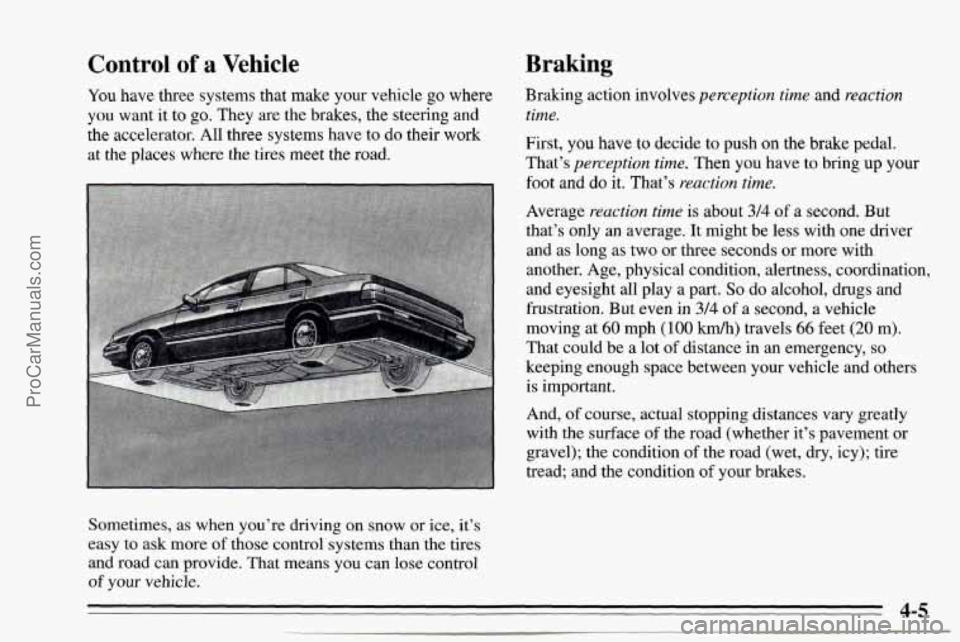
Control of a Vehicle
You have three systems that make your vehicle go where
you want it to
go. They are the brakes, the steering and
the accelerator. All three systems have to do their work
at the places where the tires meet the road.
Sometimes, as when you’re driving on snow or ice, it’s
easy to ask more
of those control systems than the tires
and road can provide. That means you can lose control
of your vehicle.
Braking
Braking action involves perception time and reaction
time.
First, you have to decide to push on the brake pedal.
That’s
perception time. Then you have to bring up your
foot and do it. That’s
reaction time.
Average reaction time is about 3/4 of a second. But
that’s only an average. It might be less with one driver
and as long as two or three seconds or more with
another. Age, physical condition, alertness, coordination,
and eyesight all play a part.
So do alcohol, drugs and
frustration. But even in
3/4 of a second, a vehicle
moving at
60 mph (100 km/h) travels 66 feet (20 m).
That could be a lot of distance in an emergency, so
keeping enough space between your vehicle and others
is important.
And,
of course, actual stopping distances vary greatly
with the surface of the road (whether it’s pavement or
gravel); the condition
of the road (wet, dry, icy); tire
tread; and the condition
of your brakes.
4-5
ProCarManuals.com
Page 133 of 354
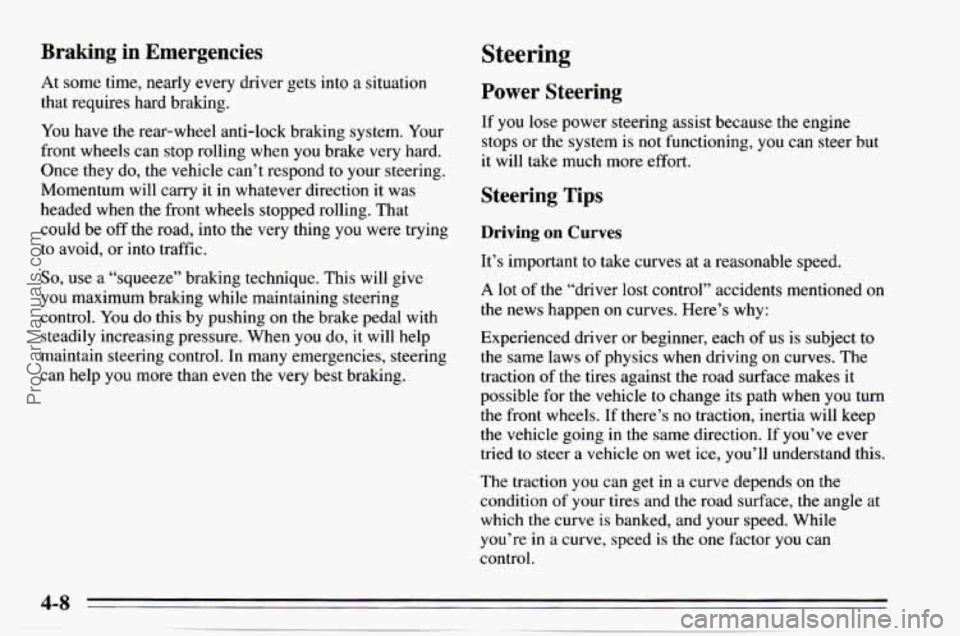
Braking in Emergencies
At some time, nearly every driver gets into a situation
that requires hard braking.
You have the rear-wheel anti-lock braking system. Your
front wheels can stop rolling when
you brake very hard.
Once they do, the vehicle can’t respond to your steering.
Momentum will carry it in whatever direction it was
headed when the front wheels stopped rolling. That
could be
off the road, into the very thing you were trying
to avoid, or into traffic.
So, use a “squeeze” braking technique. This will give
you maximum braking while maintaining steering
control. You
do this by pushing on the brake pedal with
steadily increasing pressure. When
you do, it will help
maintain steering control.
In many emergencies, steering
can help you more than even the very best braking.
Steering
Power Steering
If you lose power steering assist because the engine
stops or the system is not functioning, you
can steer but
it will take much more effort.
Steering Tips
Driving on Curves
It’s important to take curves at a reasonable speed.
A lot of the “driver lost control” accidents mentioned on
the news happen on curves. Here’s why:
Experienced driver or beginner, each
of us is subject to
the same laws
of physics when driving on curves. The
traction
of the tires against the road surface makes it
possible for the vehicle
to change its path when you turn
the front wheels.
If there’s no traction, inertia will keep
the vehicle going in the same direction.
If you’ve ever
tried
to steer a vehicle on wet ice, you’ll understand this.
The traction you can get in
a curve depends on the
condition of your tires and the road surface, the angle at
which the curve is banked, and your speed. While
you’re
in a curve, speed is the one factor you can
control.
ProCarManuals.com
Page 134 of 354
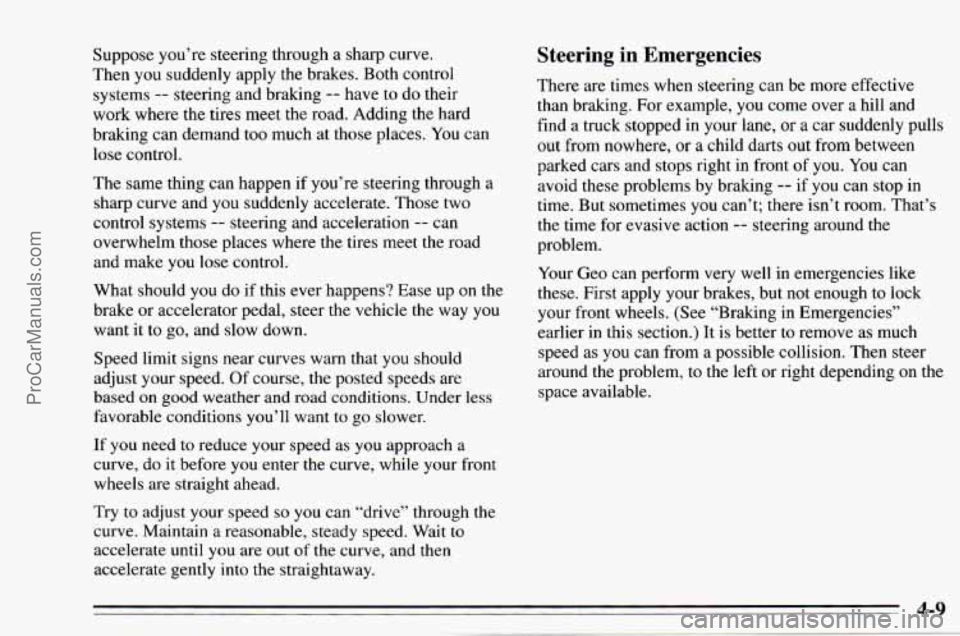
Suppose you’re steering through a sharp curve.
Then you suddenly apply the brakes. Both control
systems
-- steering and braking -- have to do their
work where the tires meet the road. Adding the hard
bralung can demand too much at those places. You can
lose control.
The same thing can happen if you’re steering through
a
sharp curve and you suddenly accelerate. Those two
control systems
-- steering and acceleration -- can
overwhelm those places where the tires meet the road
and make
you lose control.
What should
you do if this ever happens? Ease up on the
brake or accelerator pedal, steer the vehicle
the way you
want it to go, and slow down.
Speed limit signs near curves warn that
you should
adjust your speed.
Of course, the posted speeds are
based on good weather and road conditions. Under less
favorable conditions you’ll want to go slower.
Steering in Emergencies
There are times when steering can be more effective
than braking. For example,
you come over a hill and
find a truck stopped in your lane,
or a car suddenly pulls
out from nowhere,
or a child darts out from between
parked cars and stops right in front
of you. You can
avoid these problems by braking
-- if you can stop in
time. But sometimes
you can’t; there isn’t room. That’s
the time for evasive action
-- steering around the
problem.
Your Geo can perform very well in emergencies like
these. First apply your brakes, but not enough to lock
your front wheels. (See “Braking in Emergencies’’
earlier in this section.) It is better to remove
as much
speed as you can from a possible collision. Then steer
around the problem,
to the left or right depending on the
space available.
If you need to reduce your speed as you approach
a
curve, do it before you enter the curve, while your front
wheels are straight ahead.
Try
to adjust your speed so you can “drive” through the
curve. Maintain
a reasonable, steady speed. Wait to
accelerate until you are out
of the curve, and then
accelerate gently into the straightaway.
4-9
ProCarManuals.com
Page 137 of 354
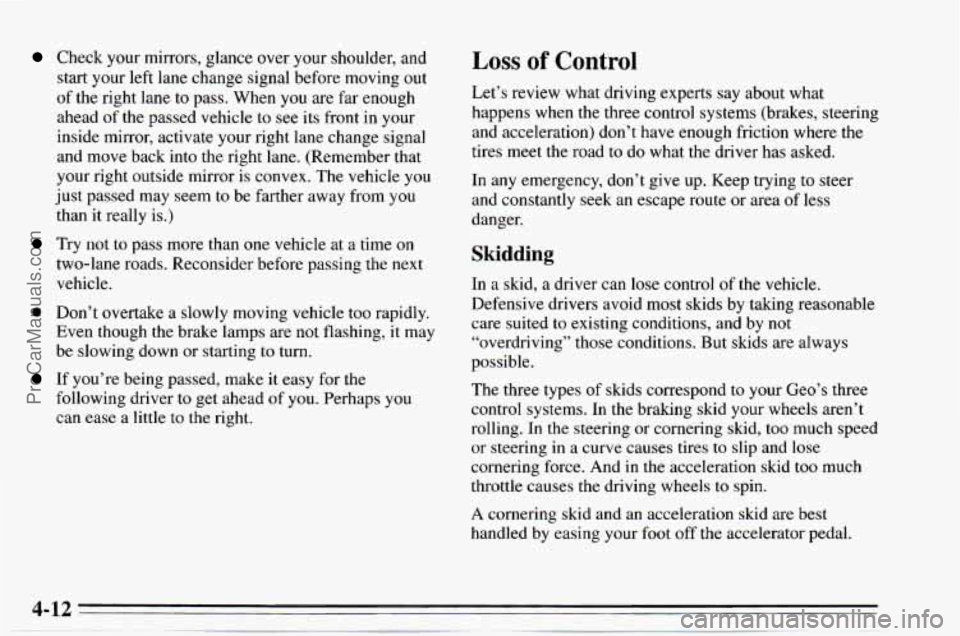
Check your mirrors, glance over your shoulder, and
start your left lane change signal before moving out
of the right lane to pass. When you are far enough
ahead
of the passed vehicle to see its front in your
inside mirror, activate your right lane change signal
and move back into the right lane. (Remember that
your right outside mirror is convex. The vehicle
you
just passed may seem to be farther away from you
than it really is.)
Try not to pass more than one vehicle at a time on
two-lane roads. Reconsider before passing the
next
vehicle.
0 Don’t overtake a slowly moving vehicle too rapidly.
Even though the brake lamps are not flashing, it may
be slowing down
or starting to turn.
following driver to get ahead
of you. Perhaps you
can ease a little to the right.
If you’re being passed, make it easy for the
Loss of Control
Let’s review what driving experts say about what
happens when the three control systems (brakes, steering
and acceleration) don’t have enough friction where the
tires meet the road to do what the driver has asked.
In any emergency, don’t give up. Keep trying to steer
and constantly seek an escape route or area
of less
danger.
Skidding
In a skid, a driver can lose control of the vehicle.
Defensive drivers avoid most skids by taking reasonable
care suited to existing conditions, and by not
“overdriving” those conditions. But skids are always
possible.
The three types
of skids correspond to your Geo’s three
control systems. In the braking skid your wheels aren’t
rolling. In the steering or cornering skid, too much speed
or steering in a curve causes tires to slip
and lose
cornering force. And in the acceleration skid too much
throttle causes the driving wheels to spin.
A cornering skid and an acceleration skid are best
handled by easing your foot off the accelerator pedal.
ProCarManuals.com
Page 138 of 354

If your vehicle starts to slide, ease your foot off the
accelerator pedal and quickly steer the way you want the
vehicle to go. If you start steering quickly enough, your
vehicle may straighten
out. Always be ready for a
second skid if it occurs.
Of course, traction is reduced when water, snow, ice,
gravel, or other material is on the road. For safety,
you’ll
want to slow down and adjust your driving to these
conditions. It is important to slow down on slippery
surfaces because stopping distance will be longer and
vehicle control more limited.
While driving
on a surface with reduced traction, try
your best to avoid sudden steering, acceleration, or
braking (including engine braking by shifting to a lower
gear). Any sudden changes could cause the tires to slide.
You may not realize the surface
is slippery until your
vehicle is skidding. Learn
to recognize warning
clues
-- such as enough water, ice or packed snow on
the road to make a “mirrored surface” -- and slow
down when you have any doubt.
Remember: The rear-wheel anti-lock braking system
(RWAL) helps avoid only a rear braking skid.
In a
braking skid (where the front wheels are no longer
rolling), release enough pressure
on the brakes to get the front
wheels rolling again. This restores steering control.
Push the brake pedal down steadily when you have to
stop suddenly. As long as the front wheels are rolling,
you will have steering control.
Driving Guidelines
This multipurpose passenger vehicle is defined as a
utility vehicle
in Consumer Information Regulations
issued by the National Highway Traffic Safety
Administration (NHTSA) of the United States
Department of Transportation, Utility vehicles have
higher ground clearance and a narrower track to make
them capable of performing in a wide variety
of off-road
applications. Specific design characteristics give them
a
higher center of gravity than ordinary cars. An
advantage
of the higher ground clearance is a better
view
of the road allowing you to anticipate problems.
They are
not designed for cornering at the same speeds
as conventional 2-wheel drive vehicles any more than
low-slung sports cars are designed
to perform
satisfactorily under off-road conditions. If at all
possible, avoid sharp turns or abrupt maneuvers.
As with
other vehicles of this type, failure
to operate this vehicle
correctly may result in loss of control or vehicle
rollover.
ProCarManuals.com
Page 140 of 354

Traveling to Remote Areas
You’ll find other important information in this manual.
See “Vehicle Loading,” “Luggage Carrier” and “Tires”
in the Index. It
makes
sense to plan your trip, especially when going
to
a remote area. Know the terrain and plan your route.
You are much less likely to get bad surprises. Get
accurate maps
of trails and terrain. Try to learn of any
blocked or closed roads.
It’s also a good idea to travel with at least one other
vehicle.
If something happens to one of them, the other
can help quickly.
Does your vehicle have
a winch? If so, be sure to read
the winch instructions.
In a remote area, a winch can be
handy
if you get stuck. But you’ll want to know how to
use it properly.
Getting Familiar with Off-Road Driving
It’s a good idea to practice in an area that’s safe and
close to home before you go into the wilderness.
Off-road driving does require some new and different
driving skills. Here’s what we mean.
Tune your senses to different kinds of signals. Your
eyes, for example, need to constantly
sweep the terrain
for unexpected obstacles. Your ears need to listen for
unusual tire or engine sounds. With your anns, hands,
feet, and body you’ll need
to respond to vibrations and
vehicle bounce.
ProCarManuals.com
Page 148 of 354
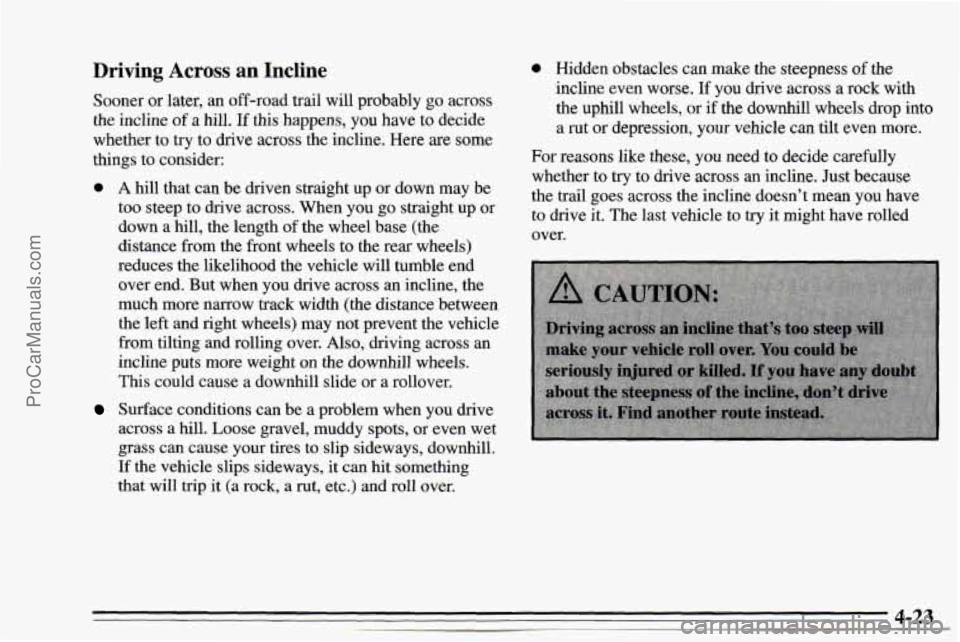
Driving Across an Incline
Sooner or later, an off-road trail will probably go across
the incline
of a hill. If this happens, you have to decide
whether to try to drive across the incline. Here
are some
things to consider:
0 A hill that can be driven straight up or down may be
too steep to dnve across. When you go straight up or
down a hill, the length of the wheel base (the
distance from the front wheels
to the rear wheels)
reduces the likelihood the vehicle will tumble end
over end. But when you drive across an incline, the
much more narrow track width (the distance between
the left and right wheels) may not prevent the vehicle
from tilting and rolling over. Also, driving across an
incline puts more weight on the downhill wheels.
This could cause a downhill slide or a rollover.
Surface conditions can be a problem when you drive
across a hill. Loose gravel, muddy spots, or even wet
grass can cause your tires to slip sideways, downhill.
If the vehicle slips sideways, it can hit something
that will trip it (a rock, a rut, etc.) and roll over.
0 Hidden obstacles can make the steepness of the
incline even worse. If you drive across a rock with
the uphill wheels, or if the downhill wheels
drop into
a rut or depression, your vehicle can tilt even more.
For reasons like these, you need
to decide carefully
whether to
try to drive across an incline. Just because
the trail goes across the incline doesn’t mean you have
to drive it. The last vehicle to try
it might have rolled
over.
4-23
ProCarManuals.com